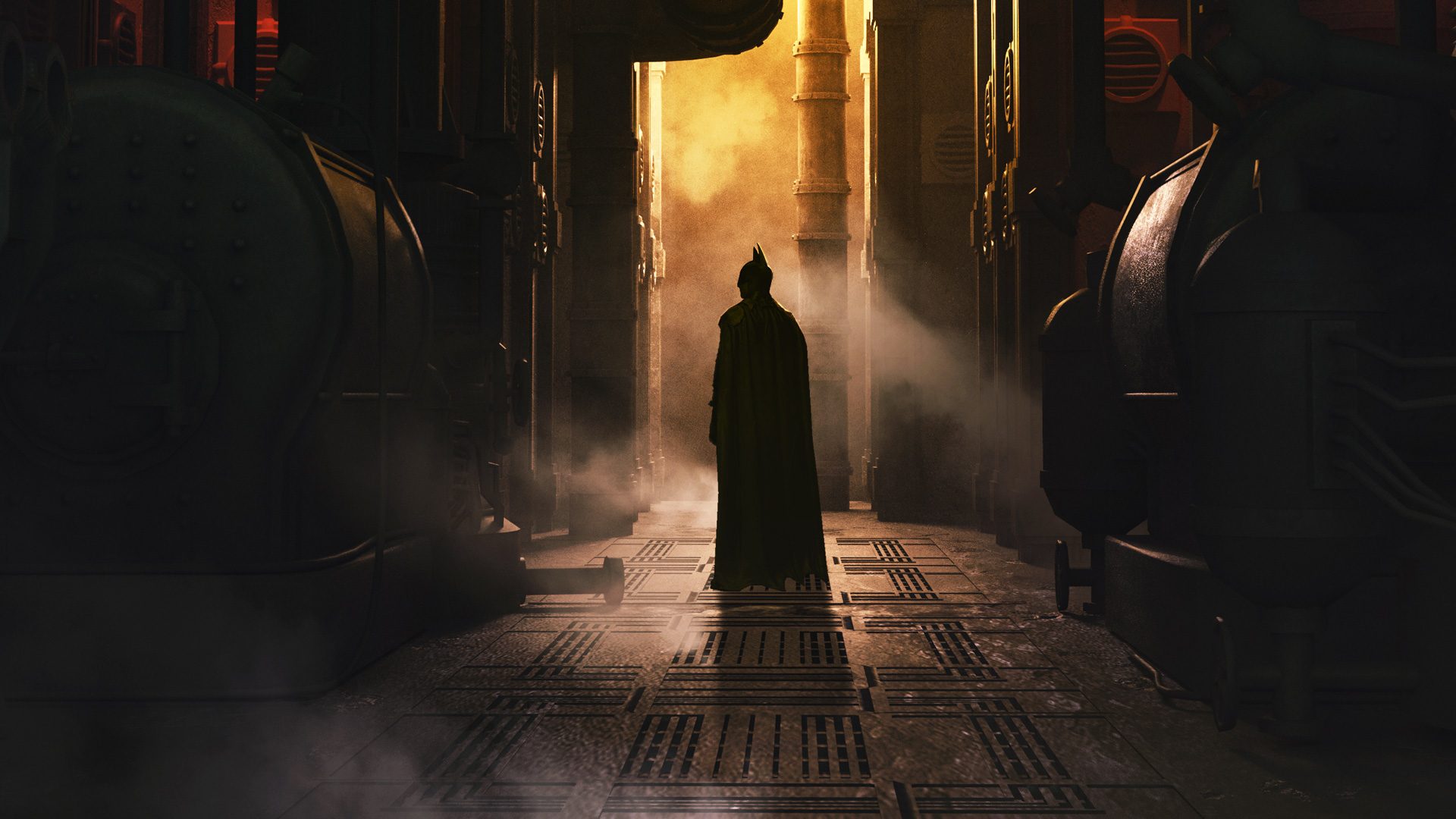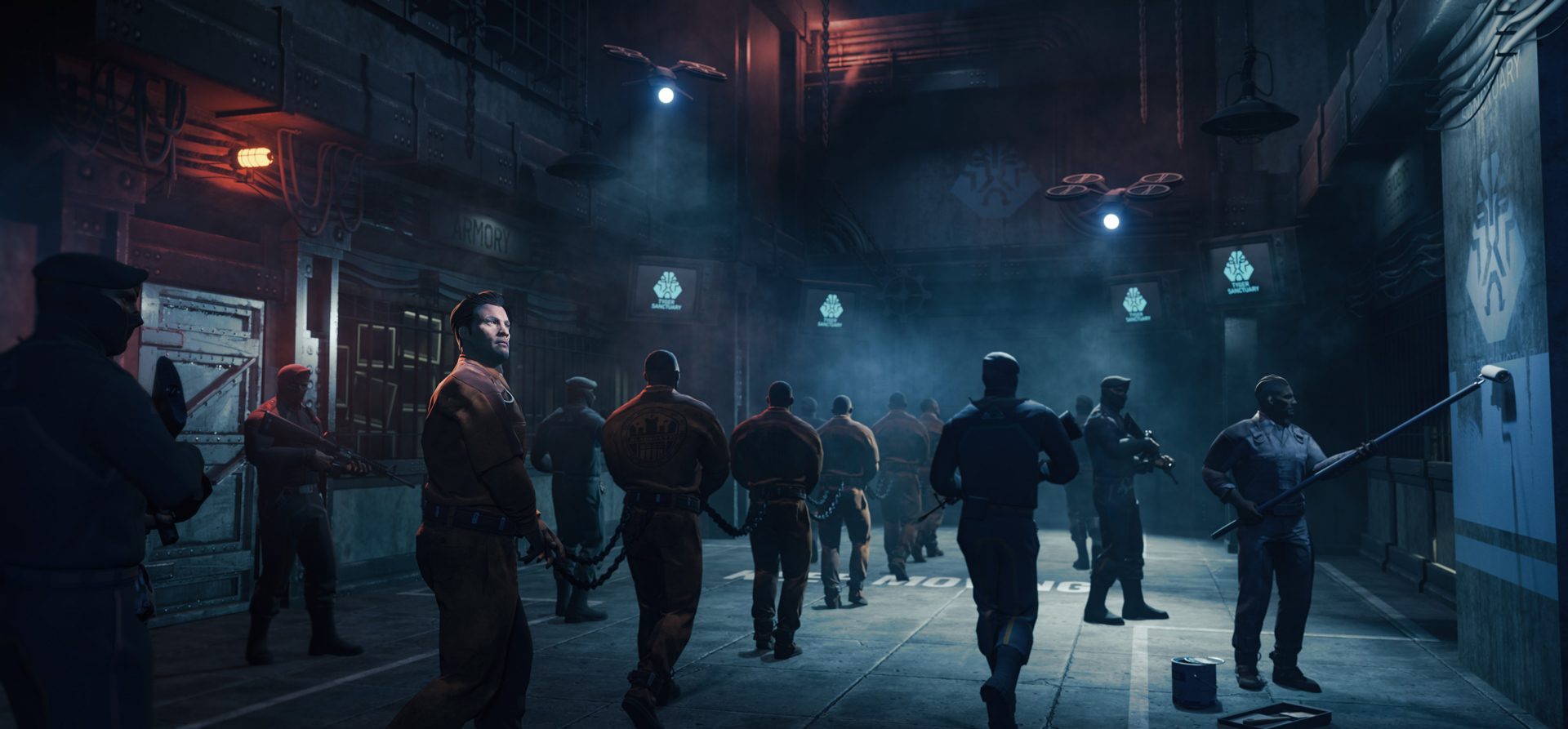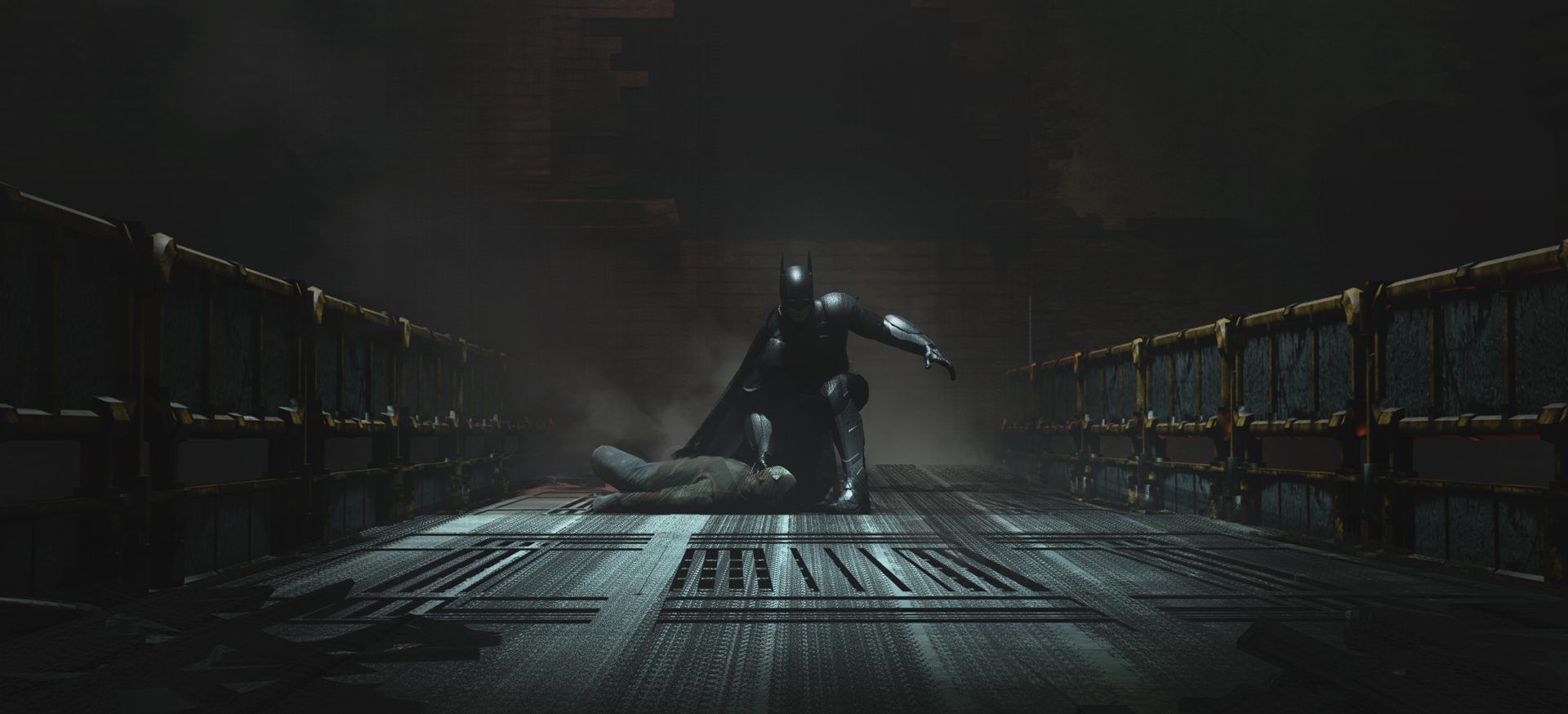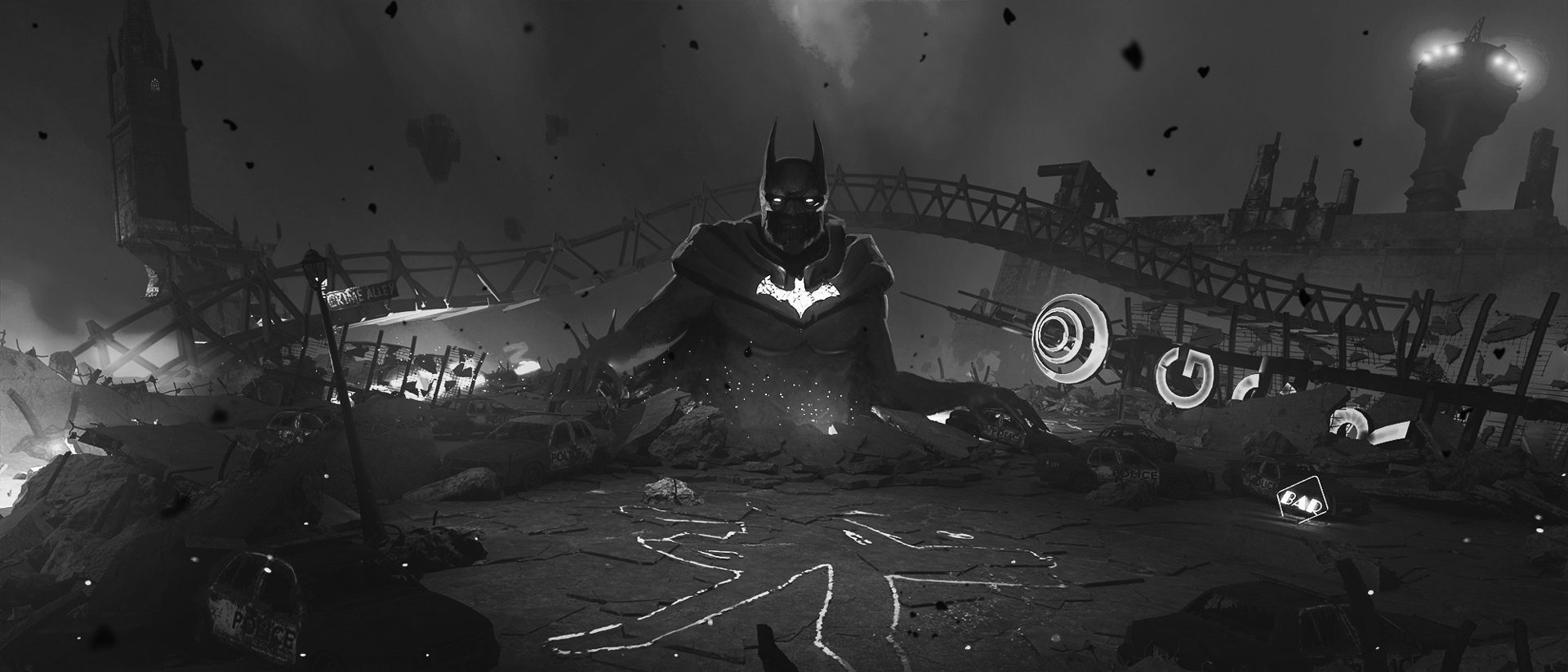Batman: Arkham Shadow had a lot to live up to. Not only were the developers trying to bring one of the world’s best known-superheroes to VR, they were also building a radical new to play a revered game series that hasn’t had a mainline entry since 2015. Following its first superhero success (Iron Man VR in 2020), Batman: Arkham Shadow launched to critical acclaim, cementing developer Camouflaj as one of the industry’s most capable and versatile VR studios. To learn more about how it all came together, we sat down to speak with game director Ryan Payton, design director Ryan Darcey, and art director Matt Kohr.
Editor’s Note: The exclusive artwork peppered throughout this article is best viewed on a desktop browser with a large screen or in landscape orientation on your phone. Also note that photos may reveal spoilers of locations and characters seen in the game. All images courtesy Meta and Camouflaj.
Bigger and Better (and Batman)
 After successfully launching Iron Man VR for PSVR in 2020 (and later bringing it to Quest), Camouflaj was ready to figure out what was next. While it would have certainly been easier to build upon the unique design of Iron Man VR for a sequel, the studio instead opted to tackle a whole new challenge, and a bigger one at that.
After successfully launching Iron Man VR for PSVR in 2020 (and later bringing it to Quest), Camouflaj was ready to figure out what was next. While it would have certainly been easier to build upon the unique design of Iron Man VR for a sequel, the studio instead opted to tackle a whole new challenge, and a bigger one at that.
“While wrapping up development work on Marvel’s Iron Man VR for PlayStation VR, we were contacted by Mike Doran and his colleagues at Oculus Studios who inquired about Camouflaj’s future plans,” recalls game director Ryan Payton. “When I told him that we were eager to do something even bigger and better in VR, that perfectly aligned with their aims, as they were on the hunt for developers who could make even bigger VR games than what was currently in the market.
Payton and his team at Camouflaj had worked with Oculus Studios on the studio’s first VR game, Republique, and was excited at the opportunity to work with them again. And even though the studio had the experience of Republique and Iron Man VR under its belt, Payton was worried about trying something as ambitious as making Arkham’s signature combat work in VR.
“[…] we explored two or three opportunities with Oculus Studios until I got the phone call that they wanted us to pitch Warner Bros Interactive on a new, VR-exclusive official entry into the Batman Arkham franchise. I remember being intrigued by the idea given how much I love Batman, but I was worried we wouldn’t be able to faithfully translate the classic freeflow Arkham combat into VR,” Payton says.
But Payton trusted the talent of his team. Especially design director Ryan Darcey, who was confident Camouflaj was up to the challenge.
“Ryan Darcey, was far more optimistic about our ability to execute on all the core Arkham tenets, especially on the gameplay side. He pointed to our ability to defy expectations with Iron Man VR and asked, ‘why couldn’t we do it again?’ Due to his high degree of confidence, I jumped head first into the pitch process with WB Interactive, focusing mainly on the high level vision and story of the title while Ryan Darcey and our incredible development team created a handful of gameplay prototypes,” says Payton. “By the end of the pitch process, we had two fantastic gameplay prototypes—one for combat, and one for grapple and cape glide locomotion—that blew everyone away. That was also right around the time our art and rendering team put together a beautiful slice of Gotham that demonstrated how great the game would look on Meta Quest. By then we were firing on all cylinders, and we haven’t let up on the gas pedal since then.”
Adapting a Known Quantity
 Camouflaj had the challenge of not just making ‘Batman’ work in VR, but an already well-defined version of Batman, complete with its own signature gameplay: the Arkham series. That meant figuring out how to bring the feeling of Arkham to the game, but making it work with the unique constraints and opportunities of VR. I asked Darcey which of the mechanics the studio built for Arkham Shadow that he liked the most.
Camouflaj had the challenge of not just making ‘Batman’ work in VR, but an already well-defined version of Batman, complete with its own signature gameplay: the Arkham series. That meant figuring out how to bring the feeling of Arkham to the game, but making it work with the unique constraints and opportunities of VR. I asked Darcey which of the mechanics the studio built for Arkham Shadow that he liked the most.
“I’d have to choose the Grapnel Gun for its versatility in VR. One of the most difficult aspects working in this medium is figuring out how the player is going to comfortably locomote through the world. Of course, we’ve got ‘smooth movement’ control on the analog sticks when you want to explore the environment immediately in front of you, but for covering great distances at speed, grappling is such a wonderful solution that the IP provides us right out of the box,” Darcey says. “In addition to its locomotive properties, acquiring the Batclaw opens up some of my favorite moments in combat. It’s so satisfying to yoink an enemy from across the room and then smash him to the ground. It feels exactly like you’d want it to feel in VR: visceral and intuitive.”
Ironically, adapting known gameplay tropes (like those already well-established in the Arkham games) for VR requires completely rethinking how things should work. Separating the concept from the mechanic—and then building brand new VR-specific mechanics that stay true to the concept—is the key challenge. When I asked Payton where he feels the game was most successful in this venture, his answer was clear.
“When you look at the critical response to the game, I think there’s no question that Batman: Arkham Shadow’s combat suite is the star of the show. The team did a fantastic job reimagining the classic Arkham combat to lean into the strengths of VR, delivering something that feels both familiar and incredibly fresh,” he says.
 Payton also recalls knowing internally that the team was onto something. Despite a mixed reaction to the initial reveal of Batman: Arkham Shadow, he says the studio kept charging ahead.
Payton also recalls knowing internally that the team was onto something. Despite a mixed reaction to the initial reveal of Batman: Arkham Shadow, he says the studio kept charging ahead.
“Back when we announced the game to the world on May 1, 2024, the internet had a visceral reaction to the game, to put it lightly. Thankfully the team at Camouflaj didn’t blink, as we were confident we were building something great. If anything, we were just eager to show more of it […],” he says. “All of this reminds me of a documentary I recently listened to about a band I follow. They knew they had a killer single from early in the recording process of their next album, so they were able to write and record the remainder of the album with confidence. I think Arkham Shadow’s combat was that ‘killer single’ we knew could carry the game if it needed to. Thankfully, however, so many other aspects of the game also landed extremely well, from the game’s story, level design, cutting edge visuals on Quest 3, and ray tracing-powered audio. It’s a complete album, if you will, and something we’re extremely proud of.”
But nailing the basic combat in VR wasn’t the only challenge. Darcey recalls the challenge of fusing the game’s standard combat with more extravagant boss fights—something the other Arkham games are well known for. To make it feel right, the studio focused on research.
“It was surprisingly difficult to create boss fights in VR. Like our other feature sets, we wanted to take inspiration from the previous titles as much as possible. We started by watching ClownPuncher’s video ranking all the Arkham boss fights and then selecting boss inspirations that both fit well with our villains and represented a variety of boss fight styles. For example, Joker Fun House in Arkham City (Horde Brawler), Deathstroke in Arkham Origins (One vs. One Brawler) and Ra’s Al Ghul in Arkham City (Giant) were all fights that we referenced for our game,” says Darcey. “Boss fights are difficult, in general, but the thing we found most difficult was translating the feel of Arkham bosses was related to the transition from third to first person. We experimented with all sorts of attacks and environmental hazards that were meant to complement the core combat, but we kept failing because there is such reduced situational awareness in first person. Ultimately, we needed to figure out a way to keep the action in front of the player whenever possible, and to avoid attacks coming in from offscreen.”
 Though the team did an impressive job of making an Arkham game for VR that still feels like an Arkham game, not everything the team attempted worked. Knowing what to cut and what to keep is part of the art of making games, and Arkham Shadow was no exception. Darcey remembers some of the work the team did that ultimately didn’t make it into the finished product.
Though the team did an impressive job of making an Arkham game for VR that still feels like an Arkham game, not everything the team attempted worked. Knowing what to cut and what to keep is part of the art of making games, and Arkham Shadow was no exception. Darcey remembers some of the work the team did that ultimately didn’t make it into the finished product.
“As it always goes with games, you’re never going to ship all the ideas you come up with, regardless of how good they are. The trick is to focus the team’s energy on the most impactful features that complement the major themes in the game and overall campaign structure,” he says. “The first major category of features that you’ll find on the cutting room floor is enemy prototypes. We largely pulled from the classic Arkham archetypes—as you’ll see in the final game—but we also experimented with some new ones, as well. One of my favorites was a four-legged TYGER Robotics dog that leveraged smell to sense the player sneaking up from behind them in predator encounters. The only way to defeat it was by attacking from above or breaking your stealth and facing it head on.”
The robo-dogs ultimately didn’t make it into the game, nor did a few of the gadgets the team had experimented with.
“Another category of features that we couldn’t fully fit in the game was gadgets,” Darsey says. “A favorite there was the Remote Batarang developed by Sean Brennan. Everyone on the team was skeptical we’d be able to recreate a comfortable experience that accurately translated the feature from the previous Arkham games, but Sean nailed it right out of the gate. Upon releasing the Remote Batarang via a throw, the camera smoothly attached itself to the Batarang and then the player was in full control flying through the air. It was slick.”